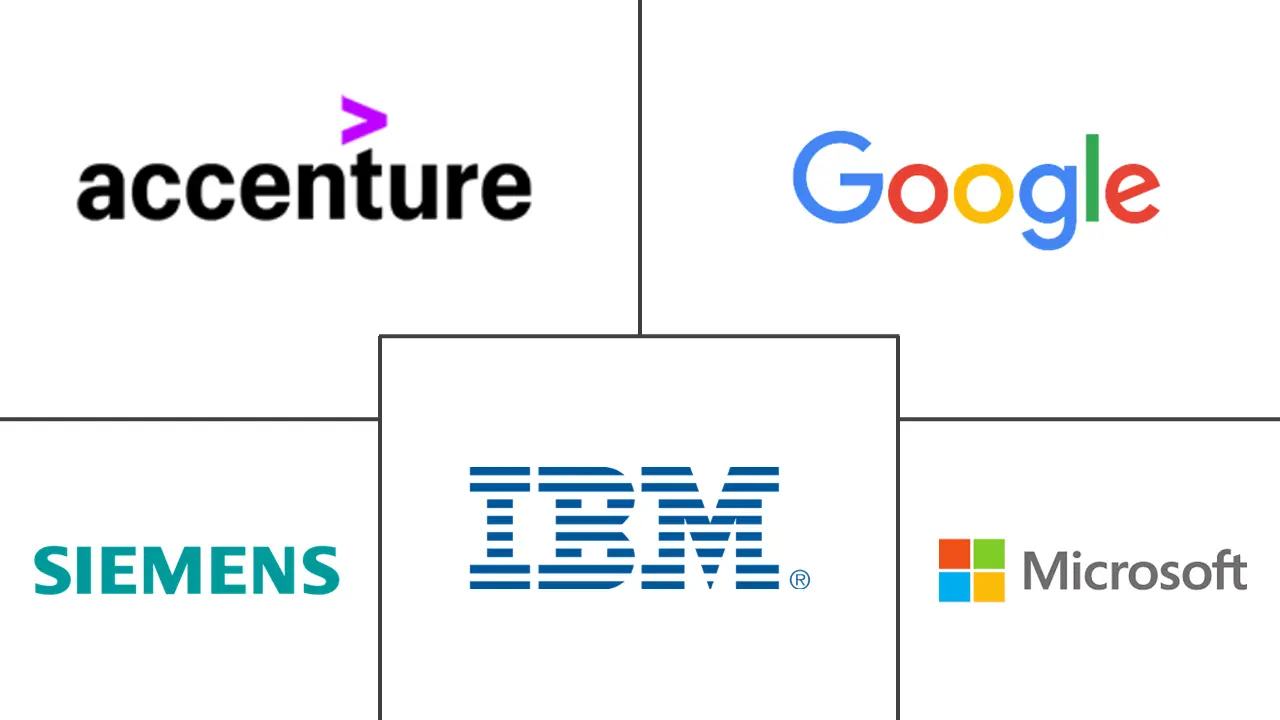Digital Transformation (DX) Market Size and Share
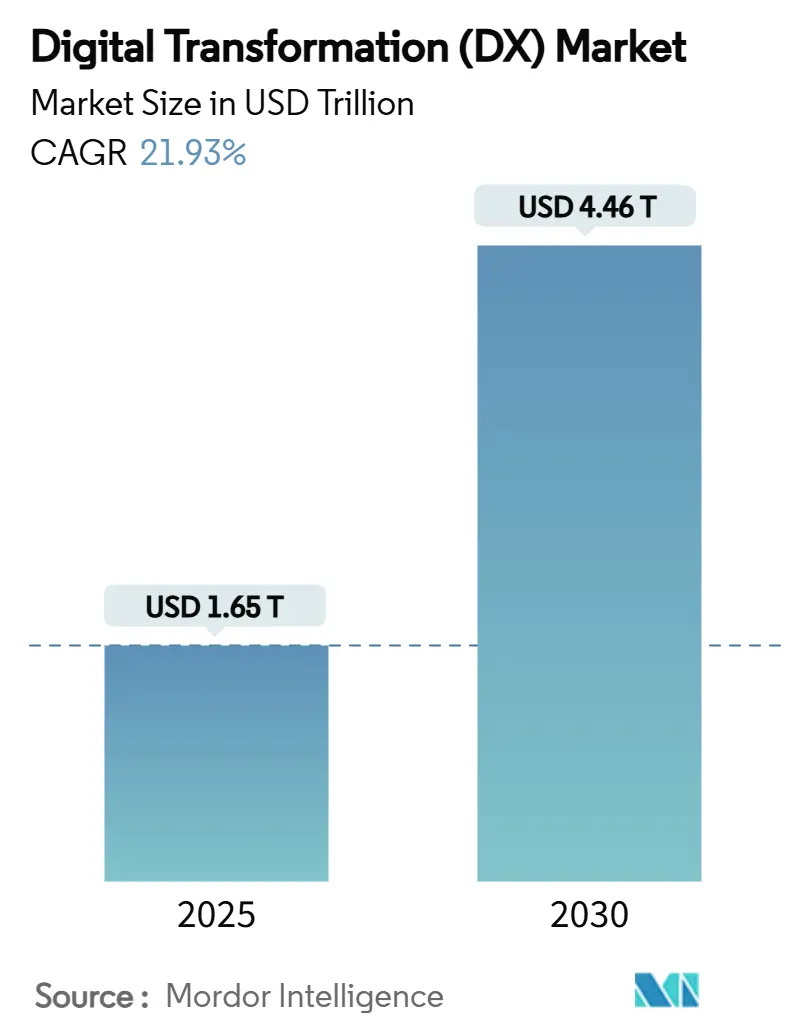
Digital Transformation (DX) Market Analysis by Mordor Intelligence
The digital transformation market is valued at USD 1.65 trillion in 2025 and is projected to climb to USD 4.46 trillion by 2030, advancing at a 21.93% CAGR. Strong growth stems from enterprise AI adoption, cloud-first spending priorities, and regulatory mandates that compel organizations to digitize operations. Sovereign-AI policies push companies to localize computing, while 5G networks open real-time use cases in manufacturing and healthcare. Low-code platforms extend application development beyond IT departments, and ESG reporting rules accelerate data-driven compliance investments. Incremental modernization strategies gain favor as enterprises balance innovation goals with legacy-system cost pressures. Competitive intensity remains moderate because businesses pursue multi-vendor cloud and AI strategies to avoid lock-in, yet hyperscale-provider capital expenditure is redefining scale economics in the digital transformation market.
Key Report Takeaways
- By technology, AI and ML held 27.8% of digital transformation market share in 2024; these solutions are forecast to grow at 24.5% CAGR through 2030.
- By deployment model, cloud-based implementations commanded 63.4% share of the digital transformation market size in 2024, and are expanding at 22.8% CAGR to 2030.
- By organization size, large enterprises captured 72.5% of digital transformation market share in 2024, while still delivering 23.4% CAGR through 2030.
- By industry vertical, healthcare is the fastest-growing segment at 22.1% CAGR, whereas BFSI retained the largest revenue contribution at 23.7% in 2024.
- By geography, North America led with 32.3% share in 2024; Asia-Pacific is the fastest-growing region at 22.4% CAGR to 2030.
Global Digital Transformation (DX) Market Trends and Insights
Drivers Impact Analysis
| Driver | (~) % Impact on CAGR Forecast | Geographic Relevance | Impact Timeline |
|---|---|---|---|
| Cloud-first enterprise IT spending boom | +4.2% | Global, with North America and EU leading | Medium term (2-4 years) |
| Rising AI/ML integration across business functions | +5.8% | Global, with Asia-Pacific and North America core | Short term (≤ 2 years) |
| 5G-enabled real-time data use-cases | +3.1% | Asia-Pacific core, spill-over to North America and EU | Medium term (2-4 years) |
| Mandatory ESG reporting digitisation | +2.4% | EU leading, expanding to North America and Asia-Pacific | Long term (≥ 4 years) |
| Digital-sovereignty public-sector funding waves | +3.7% | EU and Asia-Pacific core, selective North America adoption | Long term (≥ 4 years) |
| Low-code / no-code platforms democratising DX | +2.1% | Global, with enterprise adoption in North America and EU | Short term (≤ 2 years) |
| Source: Mordor Intelligence | |||
Cloud-first enterprise IT spending boom
Organizations are reallocating budgets from on-premise hardware toward cloud-native platforms that support AI workloads and hybrid work models. For example, Amazon Web Services resolved more than 1 million internal developer questions with its AI assistant Amazon Q, saving 450,000 hours of manual effort. [1]Swami Sivasubramanian, “Amazon Q Boosts Developer Productivity,” About Amazon, aboutamazon.comCloud economics shorten procurement cycles and shift spending from capital to operating budgets, allowing faster experimentation. Strategic deals, such as Microsoft’s partnership with Coca-Cola, show how generative-AI services ride atop scalable cloud foundations. As enterprises view cloud infrastructure as essential, vendors expand regional data centers to comply with sovereign-data rules.
Rising AI/ML integration across business functions
AI moves from pilots to production at scale. Goldman Sachs rolled out AI assistants across multiple departments, and UnitedHealth Group manages more than 1,000 AI use cases that automate claims and clinical decisions. Defense, industrial, and retail leaders replicate the pattern, embedding generative models in design, maintenance, and customer-experience workflows. Workforce upskilling and data-governance frameworks mature in tandem, making AI a core competency rather than an experimental add-on.
5G-enabled real-time data use-cases
Low-latency 5G connectivity unlocks applications that were impractical on 4G networks. Mercedes-Benz deploys private 5G to support predictive maintenance on assembly lines. Remote patient monitoring and telemedicine rely on high-definition video streams delivered over 5G links, expanding healthcare access in rural regions. Mining, agriculture, and logistics operators roll out 5G IoT sensors that feed real-time analytics engines, improving safety and asset utilization.
Mandatory ESG reporting digitisation
The EU’s Corporate Sustainability Due Diligence Directive requires Scope 3 emissions tracking, prompting companies to adopt blockchain-enabled traceability and AI analytics. Renault’s XCEED platform, built with IBM, processes 500 compliance transactions per second.[2]Ginni Rometty, “Renault and IBM Launch XCEED,” IBM Newsroom, ibm.com Investor scrutiny on sustainability disclosures escalates, turning ESG digitisation into a board-level imperative rather than a tick-box exercise.
Restraints Impact Analysis
| Restraint | (~) % Impact on CAGR Forecast | Geographic Relevance | Impact Timeline |
|---|---|---|---|
| Legacy technical-debt lock-ins | -3.8% | Global, with higher impact in North America and EU | Medium term (2-4 years) |
| Cyber-talent scarcity and wage inflation | -2.9% | Global, with acute shortage in North America and Asia-Pacific | Short term (≤ 2 years) |
| Digital-identity regulatory fragmentation | -1.6% | EU leading, expanding to global markets | Long term (≥ 4 years) |
| Scope-3 data-quality gaps for ESG audits | -1.2% | Global, with stricter requirements in EU | Medium term (2-4 years) |
| Source: Mordor Intelligence | |||
Legacy technical-debt lock-ins
Enterprises still devote up to 80% of IT budgets to maintain decades-old systems, reducing funds for innovation. ServiceNow found that aging applications cost USD 40,000 annually per system and drain 17 employee hours weekly.[3]Bill McDermott, “Legacy Systems Cost Time and Money,” ServiceNow Press, servicenow.com Government agencies illustrate the problem, spending the majority of their USD 100 billion IT outlay on legacy assets. The resulting technical debt inflates cybersecurity risk because outdated software lacks modern controls.
Cyber-talent scarcity and wage inflation
A global shortfall of 3.4 million cybersecurity specialists drives salaries to USD 138,500–585,000 for senior roles in the United States. Similar shortages in Singapore push analyst salaries above USD 121,500. Small businesses struggle to staff security programs, forcing reliance on managed service providers, while large enterprises deploy AI-driven security automation to mitigate human-resource gaps.
Segment Analysis
By Technology: AI and ML spearhead enterprise adoption
AI and ML claimed 27.8% of digital transformation market share in 2024, and the segment is expected to grow at 24.5% CAGR, reinforcing that data-driven automation is a strategic differentiator. This portion of the digital transformation market size is fueled by enterprises scaling chatbots, recommendation engines, and predictive-maintenance models. Production deployments at Goldman Sachs and Lockheed Martin exemplify the shift from pilots to mission-critical systems. Extended-Reality tools deliver 275% training-retention gains for industrial employees, while blockchain solutions such as Walmart’s food-traceability network cut provenance checks from 7 days to 2.2 seconds.
A parallel wave of edge-computing clusters processes data near sensors to avoid cloud-latency penalties. Industrial robotics synchronized with digital twins allow continuous process optimization in automotive and electronics plants. Additive-manufacturing lines use real-time prints of tooling components to shrink downtime. Together these technologies deepen the digital transformation market penetration across heavy industries.
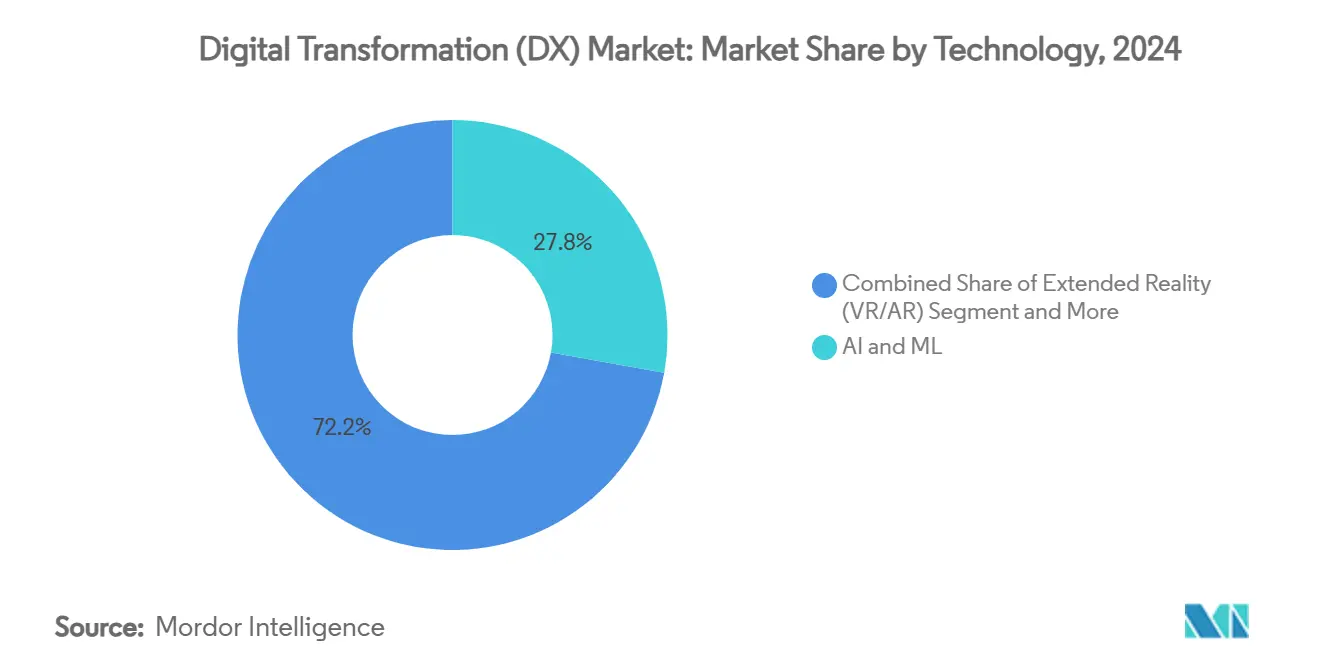
Note: Segment shares of all individual segments available upon report purchase
By Deployment Model: cloud dominance accelerates
Cloud solutions owned 63.4% of digital transformation market share in 2024 and will expand at 22.8% CAGR through 2030. This share of the digital transformation market size correlates with hyperscalers’ multi-billion-dollar data-center builds. AWS’s Project Rainier clusters Trainium 2 chips into the world’s most powerful AI training computer. Microsoft’s USD 80 billion infrastructure spend underscores escalating investment cycles. Enterprises retain on-premises nodes for regulated workloads, yet hybrid architectures flourish; Oracle’s pact with Google Cloud allows bidirectional low-latency links with no egress fees.
Cloud economics also attract small businesses that lack capital budgets for servers. Pay-as-you-go models align costs with usage, and regional availability zones satisfy data-residency regulations. Over time, platform lock-in concerns lead many firms to distribute microservices across multiple clouds, creating demand for cross-plane orchestration tools.
By Organization Size: large enterprises drive adoption
Large organizations held 72.5% of digital transformation market share in 2024 and still register 23.4% CAGR. Unilever’s “operations metaverse” digitally mirrors its global factories and supply chain, enabling continuous optimization. These resources allow parallel digital-transformation workstreams in finance, HR, manufacturing, and marketing. They also foster multi-vendor procurement strategies, reducing dependence on single platforms and spurring competitive pricing.
Small and medium enterprises catch up through low-code systems and cloud SaaS that obviate upfront hardware outlays. Yet cybersecurity staffing gaps and legacy data silos slow their progress. Collective purchasing consortiums and managed services emerge to address cost and skills hurdles for the SME cohort.
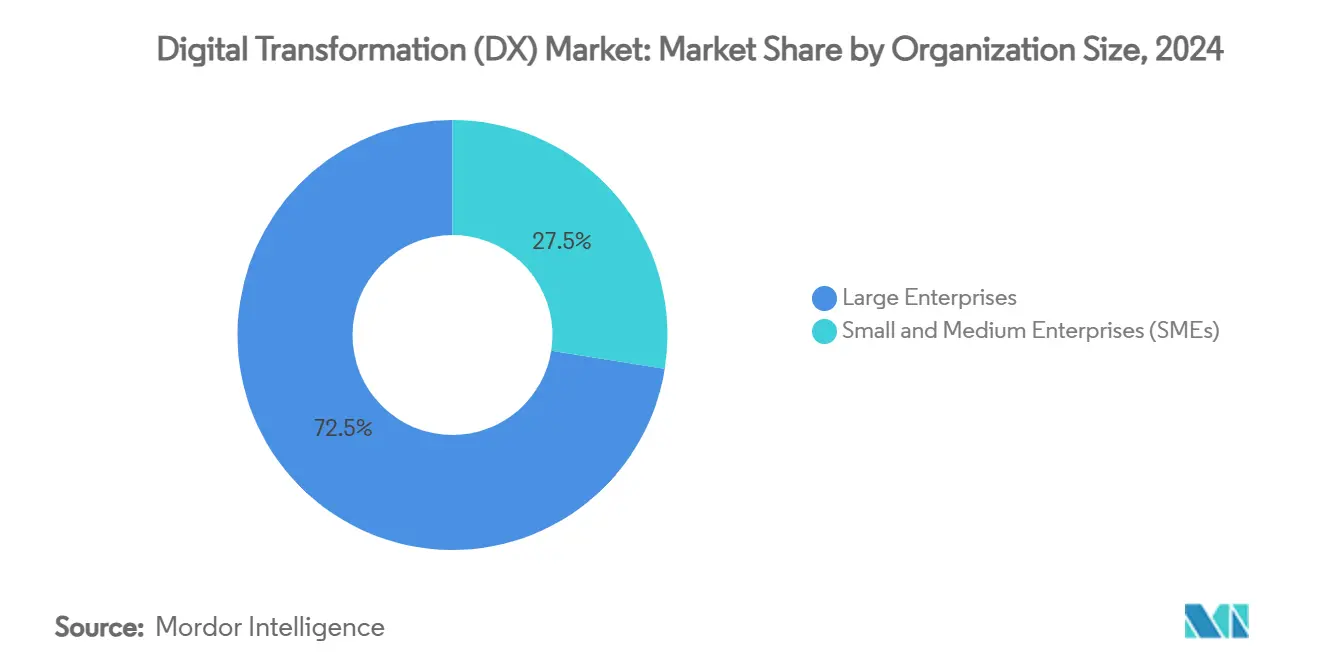
By Industry Vertical: healthcare races ahead
Healthcare is growing fastest at 22.1% CAGR as digital health-record mandates and telemedicine adoption widen. Partners HealthCare saved USD 10 million and cut readmissions 44% by integrating IoT devices with AI analytics. Pharmaceutical firms deploy machine learning for target identification and trial-data cleansing, shortening drug-discovery timelines. Medical-device makers integrate sensors for continuous patient monitoring, while hospitals employ AI chatbots to triage inquiries.
BFSI remains the largest revenue contributor at 23.7% share in 2024, upgrading core banking, fraud analytics, and digital-wallet ecosystems. Manufacturing leans on digital twins and predictive-maintenance AI to cut downtime. Retail chains harness computer-vision and edge-compute for shelf monitoring and personalized offers. Energy utilities connect smart meters to IoT platforms that balance grid loads, and government agencies roll out national digital-ID services.
Geography Analysis
North America secured 32.3% of digital transformation market share in 2024, anchored by deep venture capital pools and proximity to hyperscale-cloud headquarters. Texas alone hosts a USD 500 billion data-center expansion featuring NVIDIA supercomputers, plus Texas Instruments’ USD 30 billion chip plant that adds thousands of tech jobs. Federal and state agencies adopt AI assistants like “Humphrey” to automate administrative tasks, further boosting demand. Cross-border initiatives under USMCA support manufacturing digitisation throughout Canada and Mexico.
Asia-Pacific delivers the fastest growth at 22.4% CAGR due to extensive government infrastructure programs and mobile-first consumer behavior. Digital wallets account for nearly 70% of e-commerce checkouts, highlighting the region’s leapfrog adoption curves. India, Japan, and South Korea each articulate national AI strategies, while Australia’s Queensland earmarked AUD 1.2 billion (USD 800 million) for sovereign-cloud services. Combined, these moves expand the addressable digital transformation market.
Europe emphasizes digital sovereignty under eIDAS 2.0, mandating universal acceptance of European Digital Identity Wallets by 2027. Germany’s EuroStack program predicts EUR 300 billion investment to localize compute stacks by 2035. Schleswig-Holstein’s migration away from proprietary software shows practical implementation of sovereignty ideals. South America and the Middle East and Africa trail the leading regions but experience rising foreign investment in fiber backbones, cloud regions, and 5G rollouts, unlocking new service opportunities.
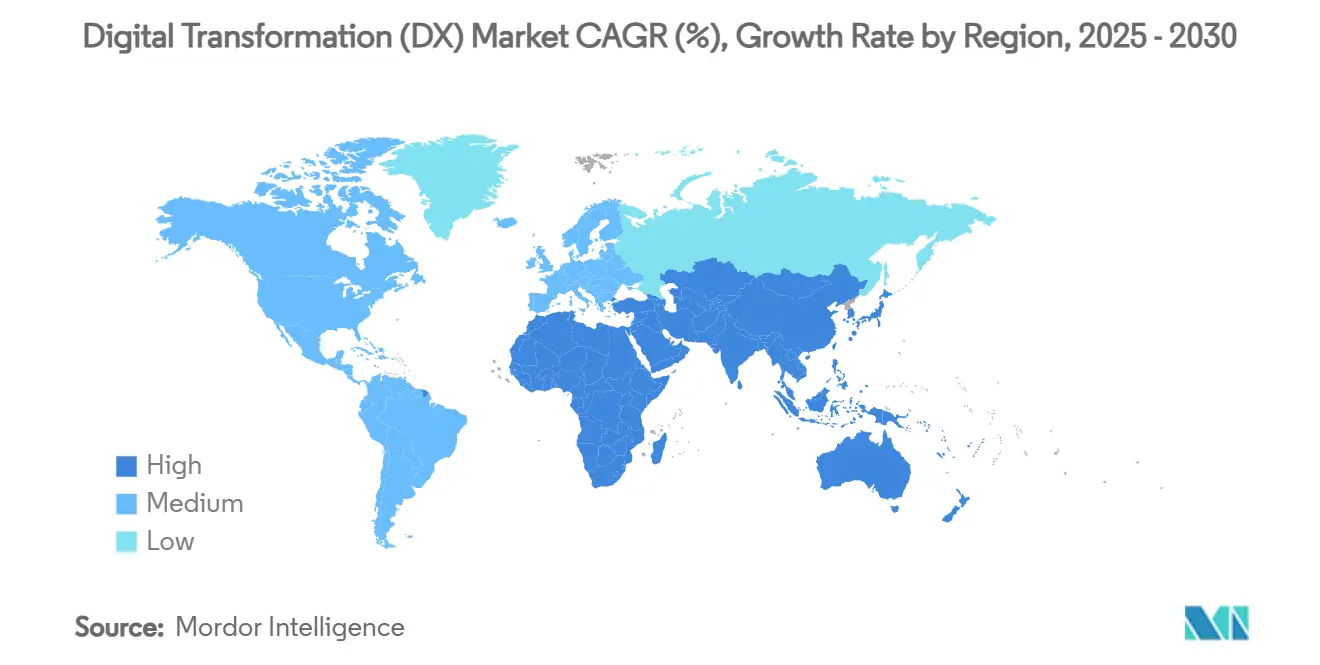
Competitive Landscape
Competition remains moderate because no single vendor exceeds one-third of total revenue, yet hyperscalers wield scale advantages. Microsoft links its USD 80 billion capex plan with co-innovation agreements at Coca-Cola, Siemens, and BlackRock. AWS counters through Project Rainier and a USD 230 million accelerator fund for AI startups that funnel workloads onto its services. Google Cloud lures senior executives from rivals to expand its AI business unit and champions open-source security tooling.
Specialist AI vendors and low-code providers attack niches the giants overlook. OutSystems, Mendix, and Retool enable domain experts to build apps with minimal coding, a shift that could reduce enterprise reliance on large-vendor professional-service teams. Intellectual property filings in generative AI accelerate as firms race to claim defensive moats. Meanwhile, multi-cloud orchestration startups compete to harmonize workloads across AWS, Azure, Google, and Oracle infrastructure.
Regulated industries complicate competitive dynamics by demanding in-country hosting, which encourages regional cloud alliances and sovereign-stack offerings. Consequently, market leaders augment portfolios with compliance toolkits and local partnerships, exemplified by Oracle’s collaboration with Google Cloud to meet data-residency rules in financial services.
Digital Transformation (DX) Industry Leaders
-
Accenture PLC
-
Google LLC (alphabet Inc.)
-
Siemens AG
-
IBM Corporation
-
Microsoft Corporation
- *Disclaimer: Major Players sorted in no particular order

Recent Industry Developments
- June 2025: AWS launched Project Rainier, building the world’s most powerful AI training computer and targeting net-zero carbon by 2040.
- March 2025: Adobe partnered with AWS and Amazon Ads to streamline omnichannel experience orchestration.
- January 2025: Microsoft unveiled a USD 80 billion AI infrastructure program to expand global data-center capacity.
- November 2024: AWS formed the Generative AI Partner Innovation Alliance to scale its Generative AI Innovation Center.
Global Digital Transformation (DX) Market Report Scope
Digital transformation is the process of incorporating digital technologies such as artificial intelligence and machine learning, extended reality (VR & AR) for industrial applications, IoT, industrial robotics, blockchain, digital twin, 3D printing/ additive manufacturing, industrial cyber security, wireless connectivity, edge computing, smart mobility, and other technologies across various end-user industry.
The digital transformation market is segmented by type (artificial intelligence and machine learning, extended reality (VR & AR) for industrial applications, IoT, industrial robotics, blockchain, digital twin, additive manufacturing, industrial cyber security, wireless connectivity, industrial 3d printing market, edge computing, smart mobility) and by geography (North America, Europe, Asia-Pacific, Latin America, Middle East and Africa). The market sizes and forecasts are provided in terms of value in USD for all the above segments.
| AI and ML |
| Extended Reality (VR/AR) |
| Internet of Things (IoT) |
| Industrial Robotics |
| Blockchain |
| Digital Twin |
| Additive Manufacturing / Industrial 3-D Printing |
| Edge Computing |
| Others |
| Cloud |
| On-Premise |
| Hybrid |
| Large Enterprises |
| Small and Medium Enterprises (SMEs) |
| BFSI |
| Healthcare and Life-Sciences |
| Manufacturing and Industrial |
| Retail and E-commerce |
| Energy and Utilities |
| Automotive and Transportation |
| Government and Public Sector |
| Others (Media, Education, etc.) |
| North America | United States | |
| Canada | ||
| Mexico | ||
| South America | Brazil | |
| Argentina | ||
| Rest of South America | ||
| Europe | Germany | |
| United Kingdom | ||
| France | ||
| Italy | ||
| Spain | ||
| Rest of Europe | ||
| Asia-Pacific | China | |
| Japan | ||
| India | ||
| South Korea | ||
| Southeast Asia | ||
| Rest of Asia-Pacific | ||
| Middle East and Africa | Middle East | Saudi Arabia |
| United Arab Emirates | ||
| Turkey | ||
| Rest of Middle East | ||
| Africa | South Africa | |
| Nigeria | ||
| Egypt | ||
| Rest of Africa | ||
| By Technology | AI and ML | ||
| Extended Reality (VR/AR) | |||
| Internet of Things (IoT) | |||
| Industrial Robotics | |||
| Blockchain | |||
| Digital Twin | |||
| Additive Manufacturing / Industrial 3-D Printing | |||
| Edge Computing | |||
| Others | |||
| By Deployment Model | Cloud | ||
| On-Premise | |||
| Hybrid | |||
| By Organization Size | Large Enterprises | ||
| Small and Medium Enterprises (SMEs) | |||
| By Industry Vertical | BFSI | ||
| Healthcare and Life-Sciences | |||
| Manufacturing and Industrial | |||
| Retail and E-commerce | |||
| Energy and Utilities | |||
| Automotive and Transportation | |||
| Government and Public Sector | |||
| Others (Media, Education, etc.) | |||
| By Geography | North America | United States | |
| Canada | |||
| Mexico | |||
| South America | Brazil | ||
| Argentina | |||
| Rest of South America | |||
| Europe | Germany | ||
| United Kingdom | |||
| France | |||
| Italy | |||
| Spain | |||
| Rest of Europe | |||
| Asia-Pacific | China | ||
| Japan | |||
| India | |||
| South Korea | |||
| Southeast Asia | |||
| Rest of Asia-Pacific | |||
| Middle East and Africa | Middle East | Saudi Arabia | |
| United Arab Emirates | |||
| Turkey | |||
| Rest of Middle East | |||
| Africa | South Africa | ||
| Nigeria | |||
| Egypt | |||
| Rest of Africa | |||
Key Questions Answered in the Report
What is the current size of the digital transformation market?
The digital transformation market stands at USD 1.65 trillion in 2025.
How fast will the digital transformation market grow?
It is forecast to rise at a 21.93% CAGR, reaching USD 4.46 trillion by 2030.
Which technology segment leads the digital transformation market?
AI and ML technologies dominate with 27.8% share and a 24.5% CAGR outlook.
Which deployment model is most popular?
Cloud implementations command 63.4% of current spending and are expanding at 22.8% CAGR.
Which region shows the highest growth potential?
Asia-Pacific is projected to expand at 22.4% CAGR due to large-scale digital infrastructure programs.
What is the main challenge to digital transformation?
Legacy technical debt absorbs up to 80% of IT budgets, slowing modernization efforts and adding security risks.
Page last updated on:
